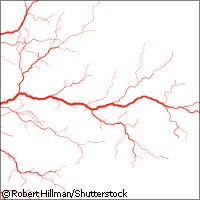Portuguese scientists discover blood vessel formation mechanism
A new blood-vessel formation and wound-healing mechanism has been discovered by Portuguese scientists. Their findings, which could lead to major advances in the treatment of chronic wounds, are published online in the journal PLoS One. Chronic wounds such as those experienced by diabetic patients are difficult to treat and take a very long time to heal. In some cases, such as in 'diabetic foot', wounds do not heal at all and amputation may become necessary. Forming new blood vessels is a fundamental part of the skin's healing process as it allows oxygen, nutrients and anti-inflammatory proteins to be carried to the site of the injury. New insights into blood vessel formation are, therefore, extremely valuable in developing wound treatment therapies. Endothelial cells line the entire circulatory system, from the heart to the capillaries, and are responsible for forming new blood vessels. At sites where blood vessels are repaired or formed anew, such as wounds, these endothelial cells are known to be stimulated by 'bone-marrow-derived vascular precursor cells' (BM-PC). BM-PCs have been the subject of intense study for the past decade, but the exact mechanism by which they contribute to wound healing has remained elusive. In seeking to understand exactly how BM-PCs communicate with blood-vessel-forming cells at wound sites, the Portuguese research team looked into the components of the Notch signalling pathway. This pathway has been implicated in the formation of endothelial cells, notably in embryos, tumours and during wound healing. The team confirmed that this pathway is essential to the repair of blood vessels, and discovered that it regulates the capacity of BM-PCs to stimulate the formation of new blood vessels. 'We knew that the endothelial cells are stimulated by cells originating in the bone-marrow,' said Francisco Caiado, a PhD student at the Gulbenkian Institute of Science in Portugal and first author of the study. 'We have now shown that the actual stimulus happens through the Notch protein, found on the bone-marrow derived cells. Upon activation, Notch promotes the adhesion of the precursor cells to the site of the lesion, where they stimulate the endothelial cells to make new blood vessels.' To test their theory that the Notch pathway is involved in the communication between BM-PCs and endothelial cells during wound healing, the scientists blocked Notch activity in BM-PCs in vitro to see what would happen. BM-PC target gene formation was reduced, as were the production of endothelial cells and the ability of the cells to stick to their targets. The researchers then increased the activation of the Notch pathway in another sample, and observed the opposite effect. They then studied the effect of Notch components on the blood-vessel-forming and wound-healing properties of BM-PCs in animals. They found that injecting normal BM-PCs into wounded mice led to increased blood-vessel formation at the wound site, but that injecting BM-PC with an inhibited Notch pathway did nothing to improve healing. They concluded that wound healing was stimulated by activating the Notch signalling pathway in BM-PCs. Inefficient wound healing is a serious medical challenge, especially in diabetic and morbidly obese patients who suffer from chronic wounds. The cause has been ascribed to a decreased ability to form blood vessels in response to injury, or to some dysfunction in bone-marrow-derived blood-vessel-forming cells. The authors of the current study suggest that the Notch pathway on BM-PCs could be exploited to stimulate the wound-healing potential of BM-PCs, a finding that has great significance for developing new treatments for chronic or delayed wound healing.
Countries
Portugal



